Hawker Typhoon MK 1B, car door, if 609 Squadron
This is the aircraft of Sq Ldr. R.P.Beamont, leader of 609 Squadron. I have no further information on the details of this squadron or it's leader.
This is the Hasegawa 1/48 kit and it was made out of the box with the exception of AeroMaster decals. It is a marvelous kit and can only be enhanced by after market cockpit details. I use the kits interior parts but if I were to build another one I would definitely use the after market detail set.

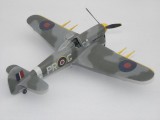

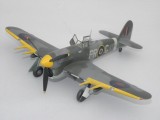

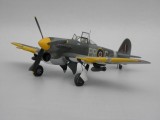
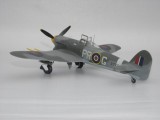
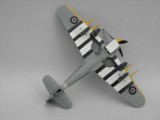
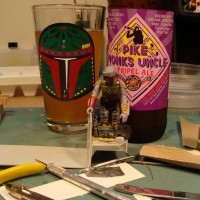
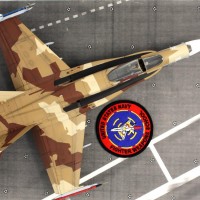
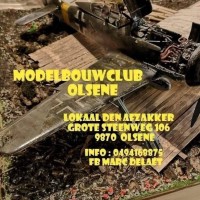
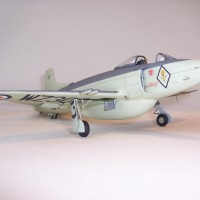
Nice clean build Frank, love the choice of markings. Now I need to try and find one of these kits (I have the bubble top). Thanks for sharing with us.
Regards,
Mark
Hey Frank, nice "Car Door"-looks like a model worthy of toasting a nice Scotch too!
Your on... Happy New Year to you and your family.
Striking paint finish, very nice and clean!
Hi Frank, here is a bio of R.P. Beaumont from Aces High by Christopher Shores. Quite the career. More info than you know what to do with.
BEAUMONT, Roland Prosper, was granted a commission in the RAF shortly before the war. In November 1939 he was posted to France where he joined 87 Squadron, part of the Air Component. A quiet period followed until the 'Blitzkrieg' broke out in May 1940, and on the 13th of that month he shot down a Do 17. He returned to England on leave, then rejoined the squadron at Church Fenton. On 24 July he destroyed a Ju 88, and on 15 August, after the start of the Battle of Britain, he shot down two Bf 110s, and damaged two others. Ten days latger he shot down two more aircraft, this time a Bf 109 and a Do 17. During September he flew mainly night sorties, damaging three aircraft, but not being able to confirm any of them as destroyed. He then flew with a detachment at St. Mary's on the Scilly Isles, hunting enemy flying-boats, but saw no action. Shortly after, he received the DFC and was posted to 79 Squadron in South Wales. At the end of 1941 he spent some months production testing Hurricanes and early Typhoons, and in 1942 was posted to 56 Squadron as a flight commander to fly the Typhoon operationally. Shortly after, he was posted to 609 Squadron, and ten weeks later became CO. During his period in command he did much to help iron out the snags in the Typhoon, he also flew many sorties along the French coast, including 'train busting' at night. In May 1943 his second tour expired, and he returned to Hawkers, where he was introduced to the Tempest, and in March 1944 became wing leader of the first Tempest wing of 3, 486 and 56 Squadrons. Until the invasion he led train-strafing attacks, and destroyed a Ju 188 on the ground at Corneilles airfield. On 8 June 1944, just after the invasion, he at last met the enemy again, and destroyed two Bf 109s over Dieppe, his first victories for nearly four years. From then on he was heavily engaged with the V-1s, and by September had destroyed 32 of these. Late in September he led the wing to Europe, being based at Brussels, and then Volkel. On 2 October he destroyed a Fw 190, bringing his score to 10. He was then offered a job at Hawkers again, but as he had flown ninety-four sorties over enemy territory he decided to complete the 100 first. His next sortie over enemy territory, he was shot down by flak, and spent the remaining months of the war as a prisoner of war. Released by the Russians, he returned to England to form a Tempest 2 wing to fight in the Far East, but the war ended before they were ready. During the war a DSO and a Bar to his DFC were added to his decorations. After a spell at the Central Fighter Establishment, he joined Gloster Aircraft as a test pilot, and then became chief test pilot for English Electric, flying the prototype Canberra and Lightning, and setting up a cross-Atlantic record in the Canberra.
Alan,
Again, outstanding info and thank you. Goes to the files along with the Spit info. As I said in another post I am not an expert it either airplane and this is the stuff I like. I am actually more interested in the person rather than the plane. I am seriously tempted to go for the 1/24 Airfix Typhoon. Don't ask me why I would want a giant model and I may come to my senses before it actually comes out. Thanks again.
If we used good sense, Frank, life wouldn't be half as interesting.
When he set the trans-Atlantic record in he Canberra, he was bringing film of Queen Elizabeth's coronation (long before the days of communications satellites).
Probably one of the top English pilots of all time.
Nice 'Tiffie' Frank; Love the yellow spinner & cannon. The Hasegawa Typhoons are lovely kits & you've done a great job here.
Cheers,
Tony.
Another great job, Frank. I am a big fan of yours, and for good reason !
Here is some more info Frank. This is from the book "Twenty-One Squadrons: The History of the Royal Auxiliary Airforce 1925-1957" by Leslie Hunt. 609 (West Riding of Yorkshire) Squadron was an auxiliary squadron formed in 1936, whose motto on their crest is, stereotypically, "Tally Ho".
"On 29th June [1942], another milestone as Flight Lieutenant Roland Beamont, DFC, ["Aces High" used Beaumont] reported as flight-commander, a member of 87 Squadron in France in 1940 and later a test-pilot for the Hawker Aircraft Company. The diary note read 'By many he is regarded as an anachronism - he ought either to be dead or a wing commander'. p. 208
"In November the squadron was moved to Manston, Kent, for operations ... [t]he 'shooting season' opened with Beamont destroying a locomotive and, in December, an impressive list of successes including four FW. 190s, with six others left damaged, plus a Ju. 88 shot down. Ground targets included eighteen locomotives destroyed or disabled, much rolling stock left ablaze and a tug reduced to firewood. So low did squadron pilots fly to avoid detection by enemy radar that one aircraft returned with a fish in the radiator - in the beak of a seagull!" p. 209
"January of 1943 was a turning-point in the story of the Typhoon; rushed into RAF service ahead of time and before some of the teething troubles had been ironed-out. Hated by many Spitfire pilots, consistently attacked by our own fighters in mistake for the FW. 190 (because in flight the 'Tiffie' radiator scoop gave the impression of a radial engine) and constantly fired-on by or own Ack Ack. It was largely due to Bea Beamont and some pilots of 609 that Figher Command retained the tough, fast, and inelegant fighter when (in the words of Flight Lieutenant Ziegler) 'most pilots except the C.O. would have exchanged their Typhoons for Spitfires with a whoop of joy!'. Bea Beamont had helped with production tests of the Typhoon during a rest from operations and he it was who had to convince his superiors that it should not be withdrawn from squadron service." p. 209
Thanks for posting your photos Frank. It gave me a chance to bring some books off the shelf and learn a lot about the plane and pilot. Didn't know he was such a central figure. Makes sense that the model company chose his markings for their product.
Very nice Frank
Weird, it didn't include a note I made in the first passage from p. 209. In November the locomotive is Beamont's but looking at his biography, it seems the December stats in the rest of the paragraph applies to the whole squadron. The writer is not clear on that.
The second passage from p. 209 should have the wording "... and constantly fired-on by OUR own Ack Ack."
Great Typhoon Frank, I like the yellow bits. Now I need to track one of these down to go next to my bubble top.
It's a great model of a great looking aeroplane, Frank, another good job!
a beauty...love the car door best
Thank you all...
Very handsome Typhoon. As for info about 609 Sqn, they made themselves famous for having enlisted a goat in their officer ranks. I once wrote an essay about it:
http://spitfiresite.com/2010/04/the-amazing-career-of-officer-billy-de-goat.html
Martin,
Great story
Frank, once again, a great job on one of my favorites. "Bee" Beamont was an exceptional test pilot, and in addition to his extensive experience during WW2 with Hawker (Typhoon and Tempest), had the first flights on two of the most important British post war aircraft, the English Electric Canberra and Lightning.